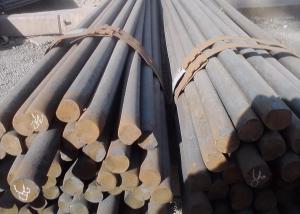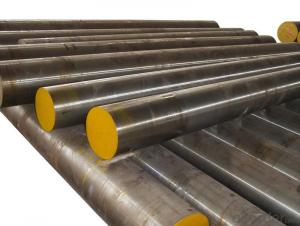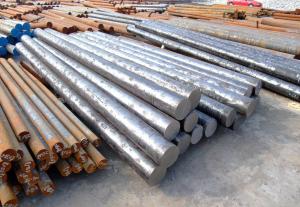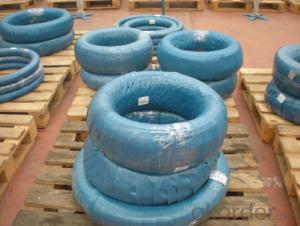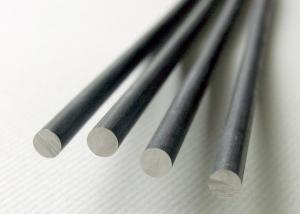ASTM 5140 Alloy Steel Bar Hot Rolled Finished
- Loading Port:
- Tianjin
- Payment Terms:
- TT OR LC
- Min Order Qty:
- 25 m.t.
- Supply Capability:
- 50000 m.t./month
OKorder Service Pledge
OKorder Financial Service
You Might Also Like
Item specifice
ASTM 5140 Alloy Steel Bar Hot Rolled Finished
Product Description:
Item | Alloy steel bar,alloy steel rod,steel bar,steel rod,alloy bar,alloy rod |
Standard | ASTM,AISI,SUS,GB,JIS,DIN |
Material | 10#,15#,20#,A105,1010,1015,1020,1030,S25C,S35V,1035,1050,1060,20Mn, 25Mn,30Mn,40Mn,50Mn,130,20Mn2,30Mn2,35Mn2,15Cr,15CrMo,42CrMo, 42CrMo4,34CrMo4,30CrMo,12CrMo,40Cr,35CrMo,C45,1045,4130,3140,4140, 4145,4137,5115,etc
|
Dimension | Round bar:Diameter:2-1000mm,Length:1-12m,or as required |
Flat bar:thickness:0.3-500mm,Width:2-3000mm,Length:1-12m,or as required | |
Square bar:Diameter:2*2-800*800mm,Length:1-12m | |
Angle bar:width:10*10-500*500mm,Thickness:2-150mm,Length:1-12m | |
Hexagonal bar:Diameter:4-800mm,Length:1-12m,or as required | |
Surface | polished,bright,black,coated,2b,ba,mirror,NO.4,8K |
Treatment | Hot rolled,cold drawn,Forged |
Package | Standard export seaworthy or as customers’ requirements |
Chemical Composition
Item | C | Si | Mn | P ≤ | S ≤ | Cr ≤ | Ni ≤ | Mo ≤ | Cu ≤ | |
GB/T 3077-1999 | 40Cr | 0.37-0.44 | 0.17-0.37 | 0.50-0.80 | 0.035 | 0.80-1.10 | 0.30 | 0.15 | 0.30 | |
Application:
Carbon steel rod applies to chemical industry,shipping industry,
manufacturing industry,construction,decorate industry,electric
power,pump shafts,sanitary wares,furniture handles,boiler,high
temperature resistant,low temperature resistant,corrosion resistant.
Product Show:

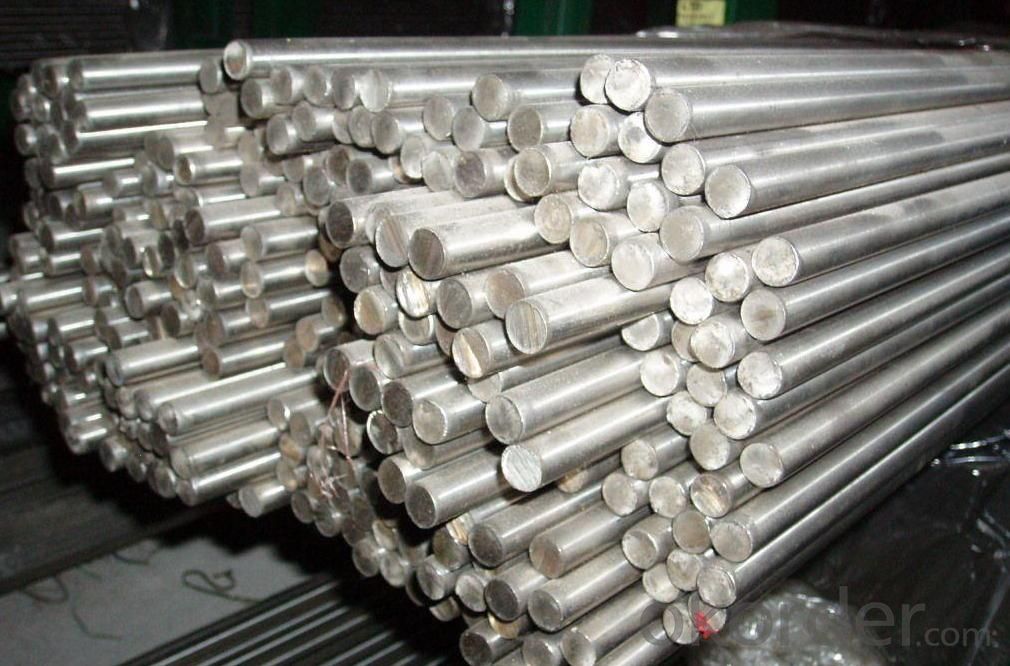
- Q:How is precipitation-hardening steel used in the aerospace industry?
- Precipitation-hardening steel is extensively used in the aerospace industry due to its exceptional strength-to-weight ratio and high corrosion resistance. It is employed in critical components such as aircraft structures, landing gears, turbine blades, and fasteners. The steel's unique property of being able to strengthen through a precipitation process allows for the manufacturing of lightweight and durable parts, resulting in improved fuel efficiency, enhanced performance, and increased safety in aircraft operations.
- Q:How does special steel contribute to the energy sector?
- Special steel contributes to the energy sector by providing high-strength materials that are essential for the construction of various energy infrastructure projects. It is used in the manufacturing of turbines, generators, and power transmission equipment, ensuring efficient energy production and distribution. Additionally, special steel is crucial in the construction of pipelines and storage tanks for the oil and gas industry, enhancing their durability and safety. Overall, the use of special steel in the energy sector plays a vital role in supporting reliable and sustainable energy production.
- Q:What are the different methods of surface powder coating for special steel?
- Special steel can be coated using various surface powder coating methods. These methods include: 1. Electrostatic powder coating: By charging the powder particles and spraying them onto the steel surface, a uniform and durable coating is achieved. The charged particles are attracted to the grounded steel. 2. Fluidized bed powder coating: Preheating the steel and dipping it into a fluidized bed of powder particles results in a smooth coating. The heat causes the powder to melt and adhere to the steel surface. Excess powder is removed through shaking or blowing air. 3. Flame spray powder coating: This method involves heating the powder particles with a flame and then spraying them onto the steel surface. The melted powder solidifies to form a coating. This method is commonly used for repairing damaged coatings or larger steel structures. 4. Thermal spray powder coating: By heating and propelling the powder particles onto the steel surface using a thermal spray gun, a dense and well-adhered coating is achieved. This method is suitable for high-wear applications and corrosive environments. 5. UV-cured powder coating: Applying a UV-sensitive powder onto the steel surface and exposing it to UV light initiates a chemical reaction that results in a hard coating. UV-cured powder coating is known for its fast curing time and excellent resistance to chemicals and UV radiation. Each method has its own advantages and considerations, and the choice depends on factors such as the specific requirements of the steel surface, desired coating thickness, and production volume.
- Q:How does special steel contribute to the renewable energy storage?
- Special steel plays a significant role in renewable energy storage by providing essential components for various energy storage technologies. For instance, it is used in the manufacturing of high-capacity batteries, such as lithium-ion batteries, which are crucial for storing energy from renewable sources like solar and wind. Additionally, special steel is used in the construction of wind turbine towers and solar panel frameworks, ensuring their durability and reliability. Overall, special steel contributes to the efficient and reliable storage of renewable energy, supporting the growth and sustainability of the renewable energy sector.
- Q:What are the different surface protection methods used for special steel?
- There are several surface protection methods used for special steel to enhance its durability and resistance to various forms of damage. One commonly used method is galvanizing, where a layer of zinc is applied to the surface of the steel. This helps to protect the steel from corrosion and rusting, increasing its lifespan and maintaining its appearance. Galvanizing can be done through hot-dip galvanizing or electroplating, depending on the specific requirements of the steel. Another method is powder coating, which involves applying a dry powder to the steel surface and then curing it in high temperatures. This creates a protective layer that is resistant to chipping, scratching, and fading. Powder coating is often used for aesthetic purposes as it provides a wide range of color options and can improve the steel's appearance. Additionally, special steel can be protected using various types of paints and coatings. These coatings can be applied through spray or brush, and they provide a barrier against corrosion, chemicals, and UV radiation. Epoxy, polyurethane, and acrylic coatings are commonly used for this purpose, depending on the specific needs and environment the steel will be exposed to. Furthermore, stainless steel is inherently resistant to corrosion due to its composition, but it can be further protected by passivation. Passivation is a chemical treatment that removes iron particles from the surface, preventing corrosion and enhancing the steel's resistance to staining and pitting. Lastly, special steel can also be protected by applying a layer of ceramic or enamel coating. These coatings provide a high level of resistance to heat, chemicals, and physical abrasion. They can be applied through spraying or dipping and are often used in environments where the steel will be exposed to extreme conditions or aggressive substances. In conclusion, the different surface protection methods used for special steel include galvanizing, powder coating, painting, passivation, and ceramic/enamel coating. These methods aim to enhance the steel's durability, resistance to corrosion, and overall lifespan, ensuring that it can withstand various environmental factors and maintain its structural integrity.
- Q:How does special steel contribute to improved product aesthetics?
- Special steel contributes to improved product aesthetics in several ways. Firstly, special steel can be manufactured with a higher level of precision and consistency compared to regular steel. This allows for the creation of products with smoother surfaces, sharper edges, and more intricate designs. As a result, products made from special steel often have a more visually appealing appearance. Additionally, special steel can be treated or coated to enhance its visual appeal. For example, it can be polished to create a reflective surface, giving the product a high-end and luxurious look. Special steel can also be coated with different colors or finishes, such as chrome or black oxide, to match specific design preferences and create a more visually striking appearance. Furthermore, special steel can be shaped and formed in unique ways due to its superior strength and flexibility. This allows designers to create products with more complex and innovative shapes, resulting in a distinct and eye-catching aesthetic. The ability to mold special steel into various forms also opens up possibilities for creating intricate patterns, textures, and embossed designs on the product's surface. Lastly, special steel offers excellent corrosion resistance and durability, which helps maintain the product's appearance over time. It prevents rust, staining, and other forms of deterioration that can negatively impact the visual appeal of a product. This long-lasting aesthetic quality is especially important for products that are regularly exposed to harsh environments or require frequent handling. In summary, special steel contributes to improved product aesthetics through its precision manufacturing, customizable surface treatments, unique shaping capabilities, and long-lasting visual appeal. These qualities allow for the creation of visually appealing products that stand out in terms of design, finish, and overall appeal.
- Q:How does cryogenic treatment affect the toughness of special steel?
- Cryogenic treatment significantly improves the toughness of special steel. It involves subjecting the steel to extremely low temperatures, typically below -150°C, resulting in the transformation of retained austenite into martensite. This process enhances the steel's microstructure, reducing residual stresses and increasing its hardness, wear resistance, and overall toughness. The cryogenic treatment also refines the grain structure, leading to improved mechanical properties and increased resistance to fatigue and cracking.
- Q:What are the different corrosion-resistant special steel alloys?
- Various industries commonly utilize several corrosion-resistant special steel alloys. Among the most popular are stainless steel, duplex stainless steel, super duplex stainless steel, and nickel-based alloys. Stainless steel, which contains a minimum of 10.5% chromium, is a widely used corrosion-resistant alloy. It forms a protective layer of chromium oxide on its surface, effectively preventing further corrosion. This alloy exhibits high resistance to rust, staining, and pitting, making it suitable for applications in the food processing, chemical, and marine industries. Duplex stainless steel, a combination of austenitic and ferritic stainless steels, offers excellent corrosion resistance, particularly in environments with high chloride ion concentrations. It finds common use in the oil and gas, chemical, and desalination industries. Super duplex stainless steel, being a stronger variation of duplex stainless steel, provides enhanced corrosion resistance and mechanical properties. This makes it ideal for applications in harsh environments like offshore oil and gas platforms, chemical processing plants, and seawater desalination systems. Nickel-based alloys, including Inconel and Hastelloy, are renowned for their exceptional resistance to corrosion and high-temperature environments. These alloys find widespread use in industries such as aerospace, chemical processing, and power generation, where both corrosion and heat resistance are critical. These corrosion-resistant special steel alloys offer a range of options for industries seeking materials with superior durability and resistance to corrosive environments. The choice of alloy depends on the specific application, operating conditions, and desired performance characteristics.
- Q:How is wear-resistant steel used in mining equipment?
- Wear-resistant steel is commonly used in mining equipment to increase its durability and prolong its lifespan. It is utilized in various components such as buckets, blades, and hammers, which are subjected to intense abrasion and impact during mining operations. By incorporating wear-resistant steel, these equipment parts can withstand the harsh conditions and abrasive materials encountered in mining, reducing the need for frequent repairs or replacements and ensuring continuous productivity.
- Q:What are the challenges in welding special steel alloys?
- Welding special steel alloys presents various obstacles due to their distinct properties and composition. Key challenges encountered when welding special steel alloys include the following: 1. Elevated melting point: Special steel alloys typically possess higher melting points compared to regular steel, necessitating increased heat input during the welding process. This can create difficulties in achieving proper fusion and may require specialized welding equipment and techniques. 2. Disparity in thermal expansion: Special steel alloys may exhibit different coefficients of thermal expansion in comparison to the base metal or other materials being joined. This can result in the development of stress and distortion during welding, impacting the structural integrity of the welded joints. 3. Heat sensitivity: Certain special steel alloys are more susceptible to heat-affected zone (HAZ) cracking and other forms of weld defects. The heightened heat input during welding can induce the formation of brittle phases or precipitates, leading to reduced mechanical properties and potential weld failures. 4. Metallurgical alterations: Welding special steel alloys can bring about significant metallurgical changes in the base metal and the heat-affected zone. These changes encompass the formation of new microstructures, variations in hardness, and modifications in chemical composition. Such alterations can affect the overall performance and properties of the welded joints. 5. Pre-weld and post-weld treatments: Specific pre-weld and post-weld treatments are often required for special steel alloys to minimize the risk of weld defects and optimize the properties of the welded joints. These treatments may encompass preheating, post-weld heat treatment, or the utilization of specialized filler metals to ensure adequate weld integrity. 6. Limited consumable availability: Special steel alloys may have a limited selection of suitable consumables, such as filler metals and shielding gases, which are vital for achieving high-quality welds. The absence of appropriate consumables can make it challenging to find compatible materials that offer sufficient strength and corrosion resistance in the welded joints. To overcome these challenges effectively, it is essential to possess a comprehensive understanding of the specific properties and requirements of the special steel alloy being welded. The utilization of proper welding techniques, including heat control, filler material selection, and post-weld treatments, is crucial to ensure welds of superior quality with optimal mechanical properties and structural integrity. Moreover, collaborating with material suppliers, welding experts, and adhering to industry standards and guidelines can facilitate the effective resolution of challenges associated with welding special steel alloys.
1. Manufacturer Overview |
|
|---|---|
| Location | |
| Year Established | |
| Annual Output Value | |
| Main Markets | |
| Company Certifications | |
2. Manufacturer Certificates |
|
|---|---|
| a) Certification Name | |
| Range | |
| Reference | |
| Validity Period | |
3. Manufacturer Capability |
|
|---|---|
| a)Trade Capacity | |
| Nearest Port | |
| Export Percentage | |
| No.of Employees in Trade Department | |
| Language Spoken: | |
| b)Factory Information | |
| Factory Size: | |
| No. of Production Lines | |
| Contract Manufacturing | |
| Product Price Range | |
Send your message to us
ASTM 5140 Alloy Steel Bar Hot Rolled Finished
- Loading Port:
- Tianjin
- Payment Terms:
- TT OR LC
- Min Order Qty:
- 25 m.t.
- Supply Capability:
- 50000 m.t./month
OKorder Service Pledge
OKorder Financial Service
Similar products
New products
Hot products
Related keywords






















